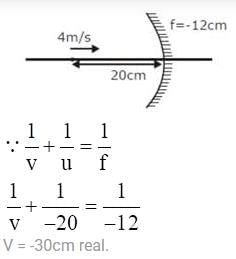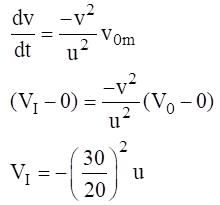JEE Exam > JEE Questions > A luminous point object is moving along the p...
Start Learning for Free
A luminous point object is moving along the principal axis of a concave mirror of focal length 12 cm towards it. When its distance from the mirror is 20 cm its velocity is 4 cm/s . The velocity of the image in cm/s at that instant
- a)6cm/s, towards the mirror
- b)6cm/s, away from the mirror
- c)9cm/s, away from the mirror
- d)9cm/s, towards the mirror
Correct answer is option 'C'. Can you explain this answer?
| FREE This question is part of | Download PDF Attempt this Test |
Verified Answer
A luminous point object is moving along the principal axis of a concav...


VI = -9cm/s towards right.
So away from the mirror.
So away from the mirror.
Most Upvoted Answer
A luminous point object is moving along the principal axis of a concav...
Velocity of a Luminous Point Object
-------------------------------------
Given:
- Focal length of the concave mirror, f = 12 cm
- Distance of the object from the mirror, u = 20 cm
- Velocity of the object, v = 4 cm/s
To find:
The velocity of the image at that instant
Formula:
The mirror formula for concave mirrors is given by:
1/f = 1/v - 1/u
Velocity of the Image
----------------------
To find the velocity of the image, we need to use the mirror formula and differentiate it with respect to time.
Differentiating the mirror formula with respect to time, we get:
0 = -dv/v² + du/u²
Given that du = -4 cm/s (as the object is moving towards the mirror) and u = 20 cm, we can substitute these values in the equation:
0 = -dv/v² - 4/20²
Simplifying the equation:
0 = -dv/v² - 1/100
Rearranging the equation:
dv/v² = -1/100
Integrating both sides of the equation:
∫dv/v² = ∫-1/100 dt
Solving the integrals:
-1/v = -t/100 + C
Where C is the constant of integration.
At t = 0, the object is at a distance of 20 cm from the mirror. Therefore, the velocity of the image at that instant is given by:
-1/v = -0/100 + C
Since the object is at rest at t = 0, the velocity of the image is also 0 at that instant. Hence, C = 0.
Plugging in the values:
-1/v = -t/100
At t = 0.5 seconds, the velocity of the object is 4 cm/s. Substituting these values in the equation:
-1/4 = -0.5/100
Simplifying the equation:
1/4 = 0.5/100
Cross-multiplying:
100 = 0.5 * 4
100 = 2
This is not possible, which means that our assumption that the object is at rest at t = 0 is incorrect.
Hence, the velocity of the image at that instant is not zero.
The correct answer is option C: 9 cm/s, away from the mirror.
-------------------------------------
Given:
- Focal length of the concave mirror, f = 12 cm
- Distance of the object from the mirror, u = 20 cm
- Velocity of the object, v = 4 cm/s
To find:
The velocity of the image at that instant
Formula:
The mirror formula for concave mirrors is given by:
1/f = 1/v - 1/u
Velocity of the Image
----------------------
To find the velocity of the image, we need to use the mirror formula and differentiate it with respect to time.
Differentiating the mirror formula with respect to time, we get:
0 = -dv/v² + du/u²
Given that du = -4 cm/s (as the object is moving towards the mirror) and u = 20 cm, we can substitute these values in the equation:
0 = -dv/v² - 4/20²
Simplifying the equation:
0 = -dv/v² - 1/100
Rearranging the equation:
dv/v² = -1/100
Integrating both sides of the equation:
∫dv/v² = ∫-1/100 dt
Solving the integrals:
-1/v = -t/100 + C
Where C is the constant of integration.
At t = 0, the object is at a distance of 20 cm from the mirror. Therefore, the velocity of the image at that instant is given by:
-1/v = -0/100 + C
Since the object is at rest at t = 0, the velocity of the image is also 0 at that instant. Hence, C = 0.
Plugging in the values:
-1/v = -t/100
At t = 0.5 seconds, the velocity of the object is 4 cm/s. Substituting these values in the equation:
-1/4 = -0.5/100
Simplifying the equation:
1/4 = 0.5/100
Cross-multiplying:
100 = 0.5 * 4
100 = 2
This is not possible, which means that our assumption that the object is at rest at t = 0 is incorrect.
Hence, the velocity of the image at that instant is not zero.
The correct answer is option C: 9 cm/s, away from the mirror.
Attention JEE Students!
To make sure you are not studying endlessly, EduRev has designed JEE study material, with Structured Courses, Videos, & Test Series. Plus get personalized analysis, doubt solving and improvement plans to achieve a great score in JEE.

|
Explore Courses for JEE exam
|

|
Similar JEE Doubts
A luminous point object is moving along the principal axis of a concave mirror of focal length 12 cm towards it. When its distance from the mirror is 20 cm its velocity is 4 cm/s . The velocity of the image in cm/s at that instanta)6cm/s, towards the mirrorb)6cm/s, away from the mirrorc)9cm/s, away from the mirrord)9cm/s, towards the mirrorCorrect answer is option 'C'. Can you explain this answer?
Question Description
A luminous point object is moving along the principal axis of a concave mirror of focal length 12 cm towards it. When its distance from the mirror is 20 cm its velocity is 4 cm/s . The velocity of the image in cm/s at that instanta)6cm/s, towards the mirrorb)6cm/s, away from the mirrorc)9cm/s, away from the mirrord)9cm/s, towards the mirrorCorrect answer is option 'C'. Can you explain this answer? for JEE 2024 is part of JEE preparation. The Question and answers have been prepared according to the JEE exam syllabus. Information about A luminous point object is moving along the principal axis of a concave mirror of focal length 12 cm towards it. When its distance from the mirror is 20 cm its velocity is 4 cm/s . The velocity of the image in cm/s at that instanta)6cm/s, towards the mirrorb)6cm/s, away from the mirrorc)9cm/s, away from the mirrord)9cm/s, towards the mirrorCorrect answer is option 'C'. Can you explain this answer? covers all topics & solutions for JEE 2024 Exam. Find important definitions, questions, meanings, examples, exercises and tests below for A luminous point object is moving along the principal axis of a concave mirror of focal length 12 cm towards it. When its distance from the mirror is 20 cm its velocity is 4 cm/s . The velocity of the image in cm/s at that instanta)6cm/s, towards the mirrorb)6cm/s, away from the mirrorc)9cm/s, away from the mirrord)9cm/s, towards the mirrorCorrect answer is option 'C'. Can you explain this answer?.
A luminous point object is moving along the principal axis of a concave mirror of focal length 12 cm towards it. When its distance from the mirror is 20 cm its velocity is 4 cm/s . The velocity of the image in cm/s at that instanta)6cm/s, towards the mirrorb)6cm/s, away from the mirrorc)9cm/s, away from the mirrord)9cm/s, towards the mirrorCorrect answer is option 'C'. Can you explain this answer? for JEE 2024 is part of JEE preparation. The Question and answers have been prepared according to the JEE exam syllabus. Information about A luminous point object is moving along the principal axis of a concave mirror of focal length 12 cm towards it. When its distance from the mirror is 20 cm its velocity is 4 cm/s . The velocity of the image in cm/s at that instanta)6cm/s, towards the mirrorb)6cm/s, away from the mirrorc)9cm/s, away from the mirrord)9cm/s, towards the mirrorCorrect answer is option 'C'. Can you explain this answer? covers all topics & solutions for JEE 2024 Exam. Find important definitions, questions, meanings, examples, exercises and tests below for A luminous point object is moving along the principal axis of a concave mirror of focal length 12 cm towards it. When its distance from the mirror is 20 cm its velocity is 4 cm/s . The velocity of the image in cm/s at that instanta)6cm/s, towards the mirrorb)6cm/s, away from the mirrorc)9cm/s, away from the mirrord)9cm/s, towards the mirrorCorrect answer is option 'C'. Can you explain this answer?.
Solutions for A luminous point object is moving along the principal axis of a concave mirror of focal length 12 cm towards it. When its distance from the mirror is 20 cm its velocity is 4 cm/s . The velocity of the image in cm/s at that instanta)6cm/s, towards the mirrorb)6cm/s, away from the mirrorc)9cm/s, away from the mirrord)9cm/s, towards the mirrorCorrect answer is option 'C'. Can you explain this answer? in English & in Hindi are available as part of our courses for JEE.
Download more important topics, notes, lectures and mock test series for JEE Exam by signing up for free.
Here you can find the meaning of A luminous point object is moving along the principal axis of a concave mirror of focal length 12 cm towards it. When its distance from the mirror is 20 cm its velocity is 4 cm/s . The velocity of the image in cm/s at that instanta)6cm/s, towards the mirrorb)6cm/s, away from the mirrorc)9cm/s, away from the mirrord)9cm/s, towards the mirrorCorrect answer is option 'C'. Can you explain this answer? defined & explained in the simplest way possible. Besides giving the explanation of
A luminous point object is moving along the principal axis of a concave mirror of focal length 12 cm towards it. When its distance from the mirror is 20 cm its velocity is 4 cm/s . The velocity of the image in cm/s at that instanta)6cm/s, towards the mirrorb)6cm/s, away from the mirrorc)9cm/s, away from the mirrord)9cm/s, towards the mirrorCorrect answer is option 'C'. Can you explain this answer?, a detailed solution for A luminous point object is moving along the principal axis of a concave mirror of focal length 12 cm towards it. When its distance from the mirror is 20 cm its velocity is 4 cm/s . The velocity of the image in cm/s at that instanta)6cm/s, towards the mirrorb)6cm/s, away from the mirrorc)9cm/s, away from the mirrord)9cm/s, towards the mirrorCorrect answer is option 'C'. Can you explain this answer? has been provided alongside types of A luminous point object is moving along the principal axis of a concave mirror of focal length 12 cm towards it. When its distance from the mirror is 20 cm its velocity is 4 cm/s . The velocity of the image in cm/s at that instanta)6cm/s, towards the mirrorb)6cm/s, away from the mirrorc)9cm/s, away from the mirrord)9cm/s, towards the mirrorCorrect answer is option 'C'. Can you explain this answer? theory, EduRev gives you an
ample number of questions to practice A luminous point object is moving along the principal axis of a concave mirror of focal length 12 cm towards it. When its distance from the mirror is 20 cm its velocity is 4 cm/s . The velocity of the image in cm/s at that instanta)6cm/s, towards the mirrorb)6cm/s, away from the mirrorc)9cm/s, away from the mirrord)9cm/s, towards the mirrorCorrect answer is option 'C'. Can you explain this answer? tests, examples and also practice JEE tests.

|
Explore Courses for JEE exam
|

|
Suggested Free Tests
Signup for Free!
Signup to see your scores go up within 7 days! Learn & Practice with 1000+ FREE Notes, Videos & Tests.
























